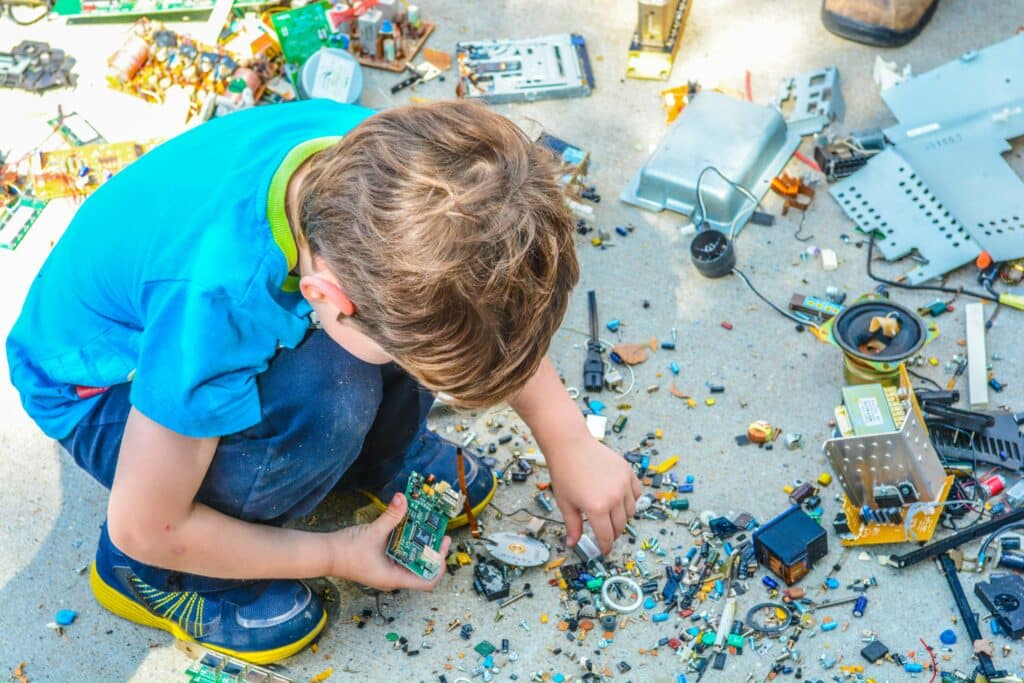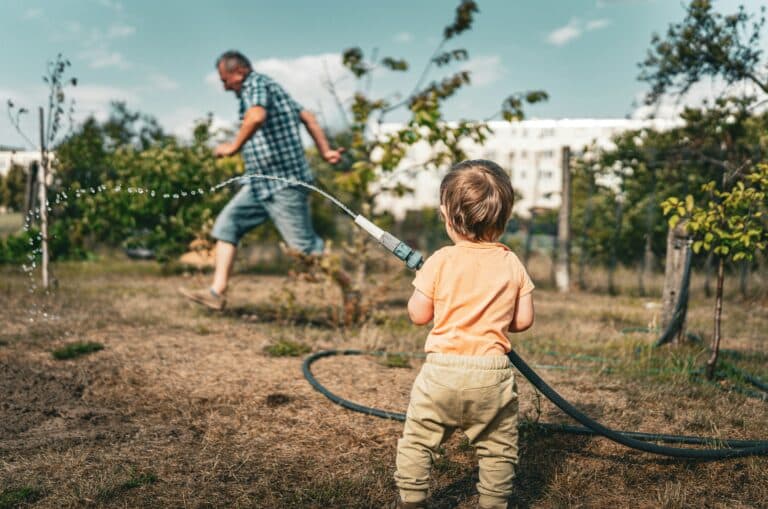🌳 🌊 Now, imagine playing a part in shaping this future, right from the comfort of your home. Sounds intriguing? Welcome to the world of eco-friendly parenting, a practical approach to child-rearing that takes Mother Earth into account, in addition to our little ones.

This holistic parenting style, while promising a greener future, can sometimes feel overwhelming—especially when you’re juggling budget concerns and attempting to minimize waste. 🌍 That’s why this comprehensive guide has been carefully curated to help you navigate the eco-parenting sphere smoothly and sustainably. From low-waste kid essentials to budget-friendly green alternatives, we’ve got you covered.
Understanding the Eco-Friendly Parenting Movement 🌿
Before we delve into the nitty-gritty of low-waste parenting, it’s essential to understand the principles underlying the eco-parenting movement. At its core, it’s about making conscious choices that lower your family’s environmental impact and foster a more sustainable world for future generations. The movement goes beyond merely recycling; it encompasses a complete lifestyle shift towards environmentally-friendly practices—right from the products you choose to the values you instill in your kids.
The Intersection of Low-Waste and Budget-Friendly Choices 💰
There’s a common misconception that going green is synonymous with high-cost living. This couldn’t be further from the truth. With proper planning and smart strategies, an eco-friendly lifestyle can be incredibly budget-friendly. In fact, many low-waste practices—like investing in reusable items or making your own baby food—often lead to significant savings in the long run.
A Sneak Peek into the Guide’s Structure 📖
This extensive guide is structured to ensure easy navigation and clear understanding. We start with the basics—educating you on the why’s and how’s of eco-friendly parenting. Next, we introduce you to the concept of low-waste essentials for kids, providing a comprehensive checklist to help you make informed purchases. We then explore the budget aspect, sharing practical tips and suggestions to balance your green choices with your financial constraints.
The Ultimate Low-Waste Kid Essentials Checklist 📝
Knowing where to start is often the biggest hurdle for parents new to the eco-friendly lifestyle. That’s why we’ve prepared an all-encompassing checklist of low-waste kid essentials to guide you. This section will detail everything from eco-friendly diapers to sustainably-produced toys, ensuring you have a solid foundation to start your green journey.
Budget-Conscious Eco-Parenting Tips 💡
Finally, we wrap up with a range of practical, budget-friendly tips to help make eco-parenting an achievable reality for your family. From DIY solutions to cost-effective swaps, this segment will arm you with the knowledge to make green parenting decisions without breaking the bank.
So, are you ready to embark on this exciting journey towards a more sustainable future? Let’s dive in and explore how you can raise eco-conscious kids without sacrificing your budget or convenience. 🌏
Understanding the Essentials of Eco-Friendly Parenting
The growing concern for the environment is driving an increasing number of parents to adopt eco-friendly lifestyles. This change doesn’t only involve reducing carbon footprints or recycling; it also entails making sustainable choices for our children. Embracing eco-friendly parenting can significantly contribute to preserving the environment for future generations. However, many parents are confused about where to start. The following discussion will outline a checklist of low-waste kid essentials for budget-conscious families.
Choosing eco-friendly products doesn’t necessarily mean spending more. On the contrary, it can help parents save money in the long run. More importantly, it helps in creating a safer and healthier environment for children. Whether it’s choosing cloth diapers over disposable ones, opting for wooden toys instead of plastic ones, or preparing home-cooked meals rather than processed foods, each decision adds up to make a considerable difference.
Let’s dive into the details of what constitutes low-waste kid essentials and how you can incorporate them into your parenting regime.
Diapers: Cloth versus Disposable
Diapers are one of the first necessities for newborns. However, conventional disposable diapers contribute significantly to landfill waste. An eco-friendly and budget-friendly alternative is cloth diapers. Although the upfront cost may be higher, cloth diapers can be reused, resulting in significant cost savings over time. They are also free from harmful chemicals found in disposable diapers, making them a healthier choice for your baby.
Moreover, cloth diapers come in various styles and designs, making them more attractive and fashionable than their disposable counterparts. Switching to cloth diapers may require a bit more work in terms of washing and drying, but the benefits for your wallet and the environment make it a worthwhile switch.
Check out the following table for a comparison between cloth and disposable diapers:
| Cloth Diapers | Disposable Diapers | |
|---|---|---|
| Cost | Higher upfront cost, but cheaper in the long run | Lower upfront cost, but more expensive over time |
| Environmental Impact | Reusable and reduces landfill waste | Contributes to landfill waste |
| Health | Free from harmful chemicals | May contain harmful chemicals |
If you’re still unsure about making the switch, consider watching “Cloth Diapers 101: A Comprehensive Guide for Beginners” by Naturally Brittany on YouTube.
Choosing Toys: Wooden versus Plastic
Children’s toys are another area where parents can make eco-friendly choices. Traditional plastic toys not only contribute to plastic waste but can also contain harmful chemicals. A safer and more sustainable alternative is wooden toys.
Wooden toys are often more durable than plastic ones, meaning they last longer and can be passed down to younger siblings or even future generations. They also encourage more imaginative play, as they tend not to be tied to specific commercial themes or characters. Plus, they have a timeless appeal that plastic toys often lack.
The table below provides a comparison between wooden and plastic toys:
| Wooden Toys | Plastic Toys | |
|---|---|---|
| Durability | Long-lasting and can be passed down | Often break easily |
| Environmental Impact | Biodegradable and fewer emissions in production | Contribute to plastic waste and higher emissions in production |
| Health | Free from harmful chemicals | May contain harmful chemicals |
To better understand the benefits of wooden toys, you can watch “The Benefits of Wooden Toys” by Hape Toys on YouTube.
Feeding Time: Home-Cooked versus Processed Foods
When it comes to feeding your children, preparing home-cooked meals using fresh ingredients is the most eco-friendly option. Processed foods often come in excessive packaging that ends up in landfills. They can also contain additives and preservatives that aren’t good for your child’s health.
Preparing meals at home allows you to control the ingredients and portion sizes. It also offers opportunities to introduce your children to a variety of healthy foods. Though it might require a bit more effort and planning, the benefits are worth it.
For tips on preparing healthy, home-cooked meals for kids, watch “Healthy Eating – Portion Control” by Nemours on YouTube. This channel provides a wealth of information on children’s health and well-being.
Greening Your Child’s Wardrobe
Clothes are another area where parents can make eco-friendly choices. Instead of buying new clothes, consider purchasing second-hand items or organizing clothes swaps with other parents. This approach not only saves money but also reduces the demand for new clothing, which often involves exploitative labor practices and contributes to environmental degradation.
When buying new items, look for clothes made from organic or recycled materials. Also, consider the longevity and versatility of the clothes. Items that can be layered or adjusted to fit as your child grows can provide better value for money and reduce waste.
For more tips on creating an eco-friendly wardrobe for your child, watch “How to Create a Capsule Wardrobe for Kids” by The Minimal Mom on YouTube.
Embarking on the journey of eco-friendly parenting might seem daunting at first, but every small step counts. Remember, it’s not about perfection but about making conscious choices that align with your values and contribute to a healthier planet. Happy green parenting!
Conclusion
In conclusion, we’ve taken a comprehensive and in-depth journey through a topic of immense significance and complexity. In an era defined by continuous technological advancement and integration, it is crucial to maintain an understanding and ability to navigate these ever-evolving landscapes of information technology and engineering.
We commenced this journey by introducing the basics, laying a foundation upon which we could build a more complex understanding. We explored the fundamentals of IT and engineering, providing a solid base for our subsequent discussions. We provided insight into the primary concepts and definitions, ensuring that all readers, regardless of their level of expertise, were on the same page. 📘
Next, we dove into the technicalities, discussing the integral aspects and components, from the nitty-gritty details to the bigger picture. Our discussions covered everything from software development processes, coding languages, network architecture, data structures, algorithm design, hardware engineering, and so much more.
We also focused on the real-world applications and implications of these areas. Our discussions were not confined to theory alone. We shed light on practical scenarios, case studies, and examples, allowing our readers to see how these concepts come alive in actual situations, and how they are shaping our world as we know it. 🌐
Throughout the article, we emphasized the importance of continuous learning in this field. In the fast-paced world of IT and engineering, complacency can be a hindrance. We encouraged our readers to stay curious, to keep exploring and expanding their knowledge base.
We hope this article has provided you with a deeper understanding and appreciation for the complexities of IT and engineering. Perhaps it has even inspired you to delve deeper, to pursue further studies or to apply what you’ve learned in your professional practice.
Feel free to leave a comment and share your thoughts. Your feedback not only enriches our community but helps us create more relevant content for you. Don’t hesitate to share this article with anyone you think might benefit from it.
For further reading, here are a few resources:
* [MIT OpenCourseWare](https://ocw.mit.edu/index.htm) – A wide range of free course materials from MIT, covering topics in IT and engineering.
* [IEEE Xplore](https://ieeexplore.ieee.org/Xplore/home.jsp) – A digital library providing access to technical literature in electrical engineering, computer science, and electronics.
* [Google Scholar](https://scholar.google.com) – A vast database of scholarly literature across many research disciplines.
Remember, the field of IT and engineering is vast and diverse. There’s always something new to learn, a new perspective to consider, a new problem to solve. Keep exploring, keep learning, and keep pushing the boundaries of what’s possible. 🚀
Author: Rodrigo Almeida, Technical Writer with a decade of experience in Software Engineering and IT. Connect with me on [LinkedIn](https://www.linkedin.com/in/rodrigo-almeida/).



